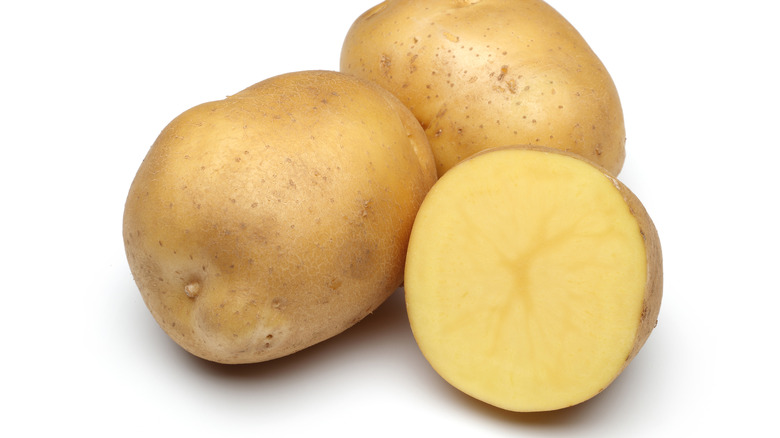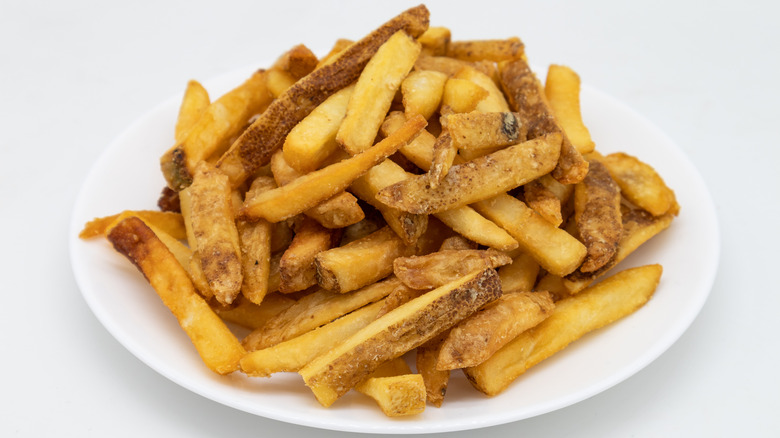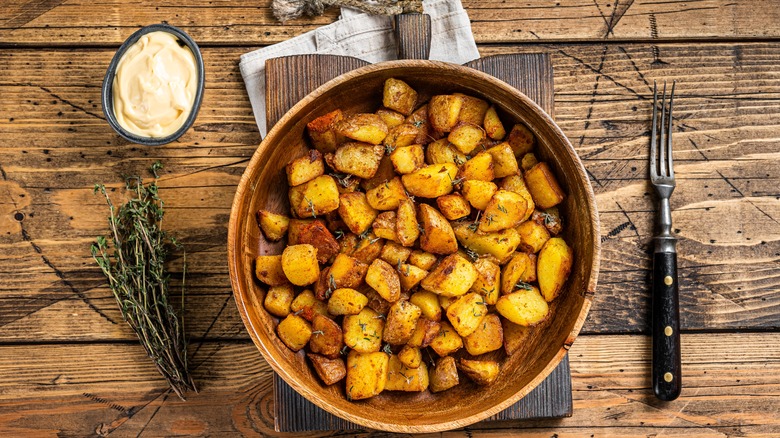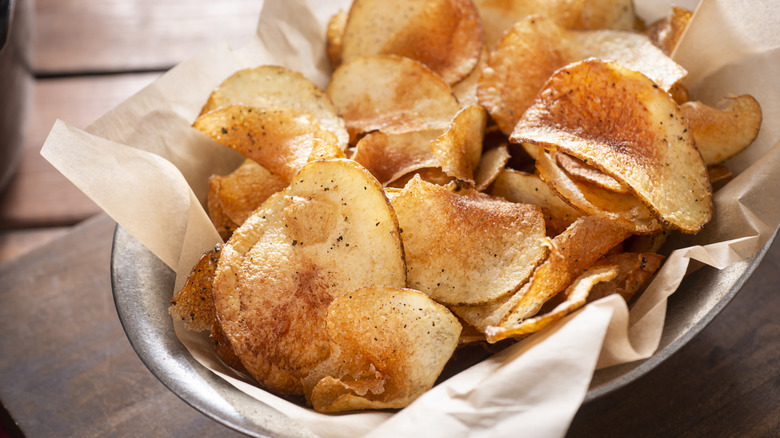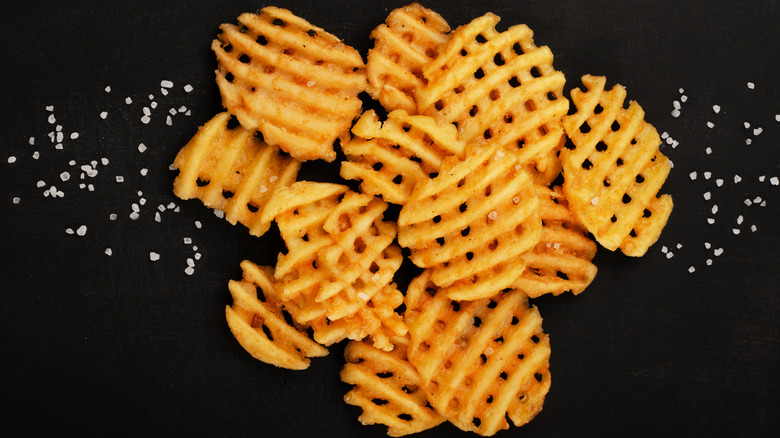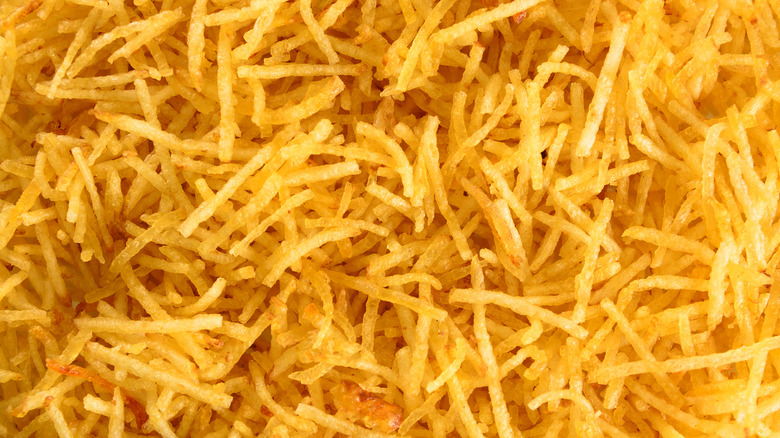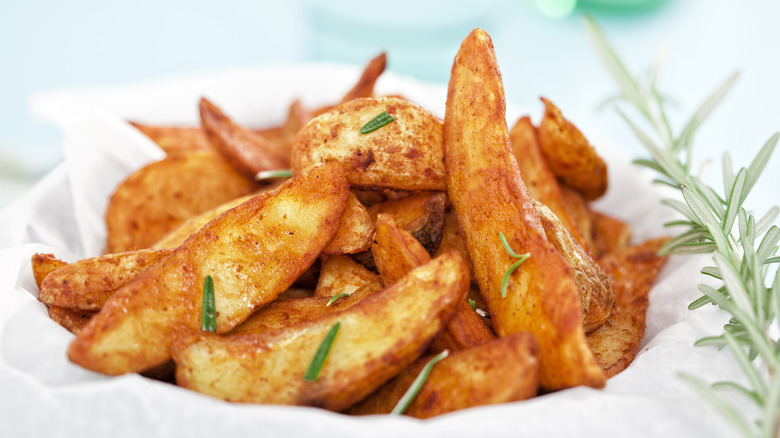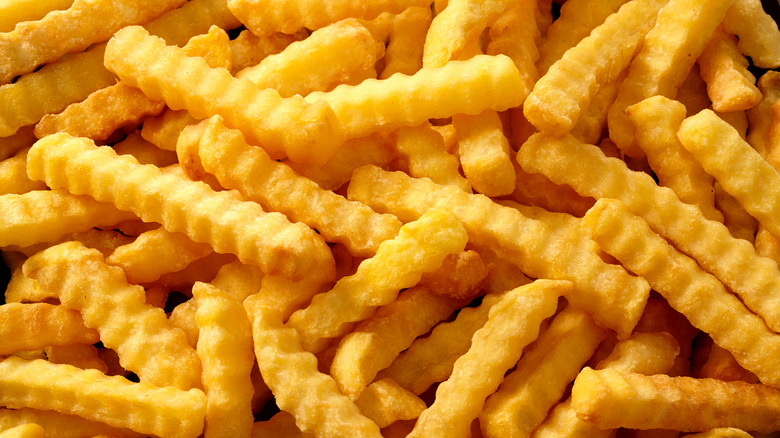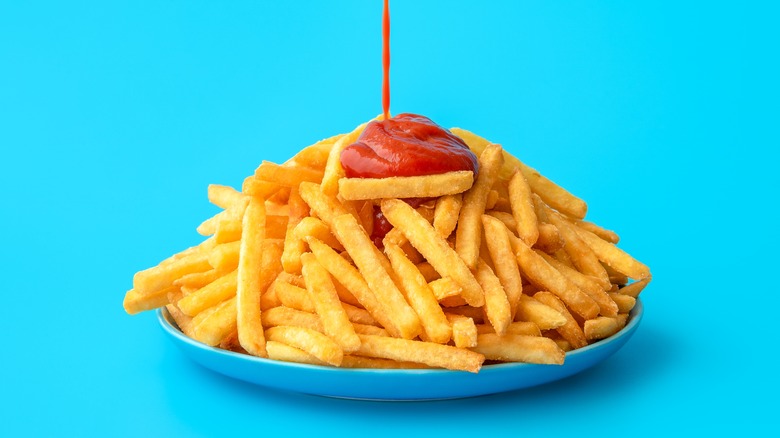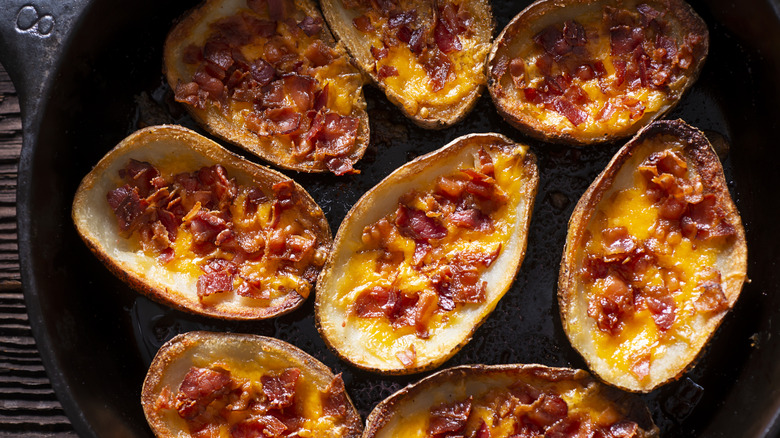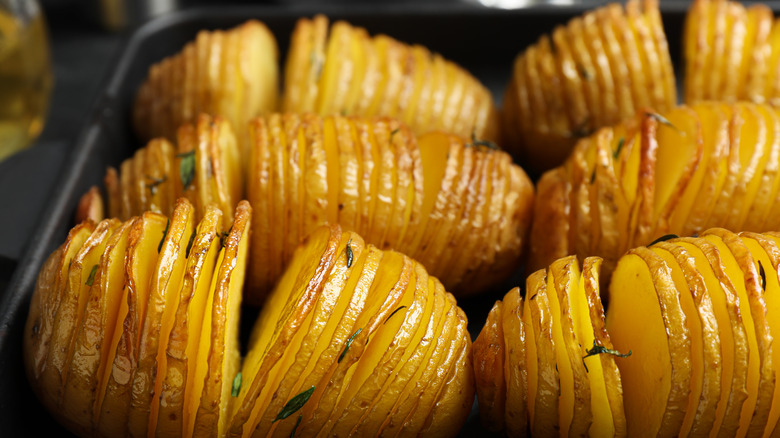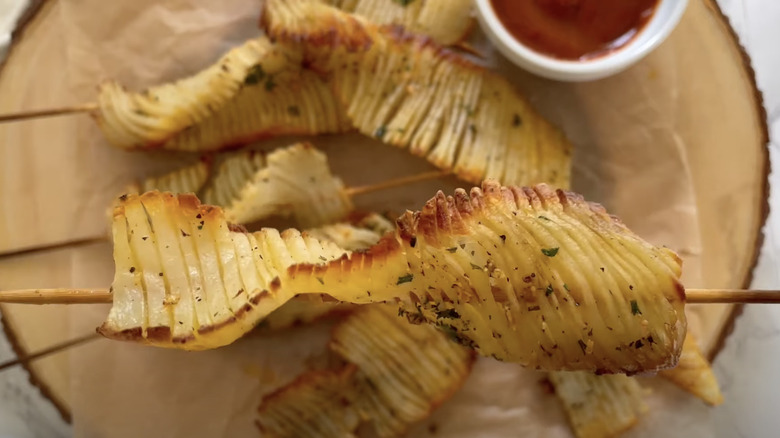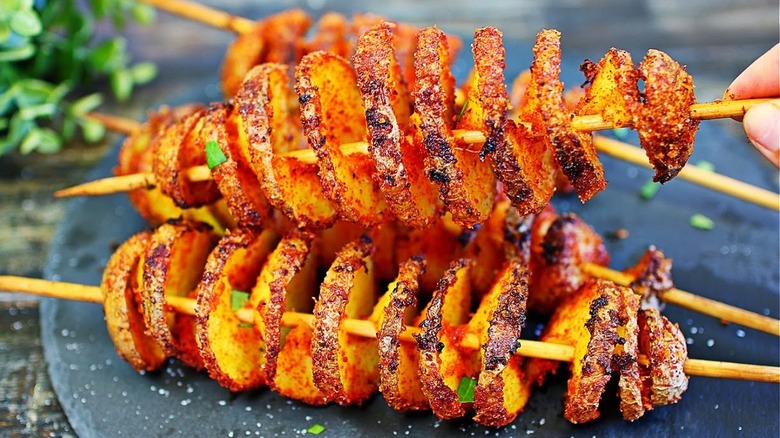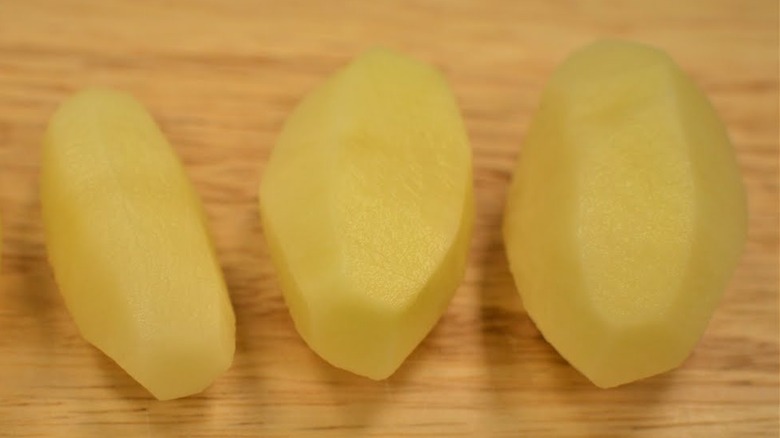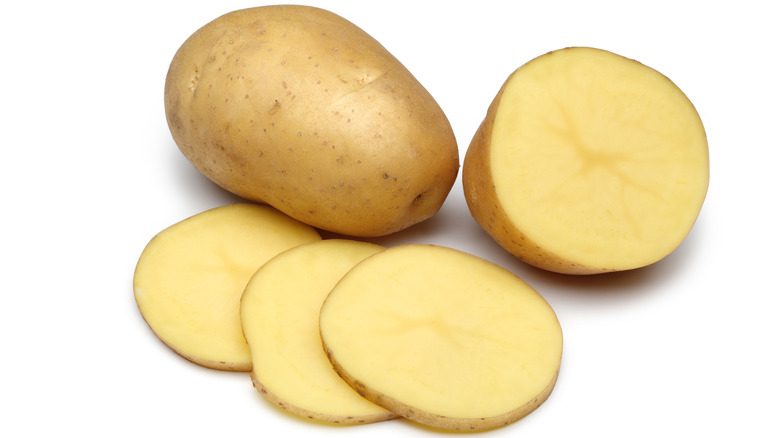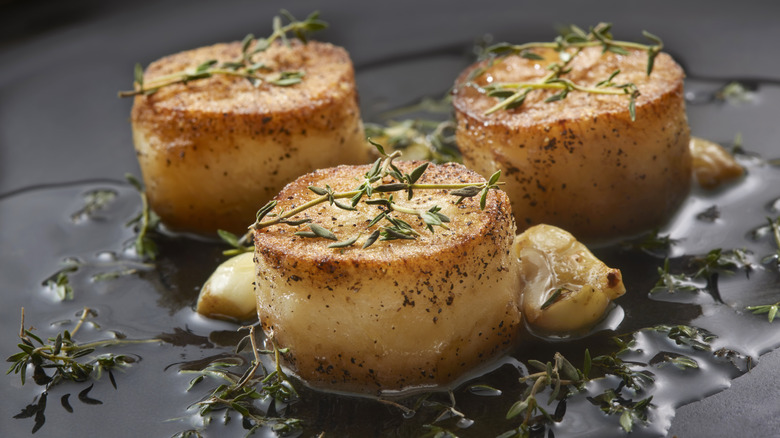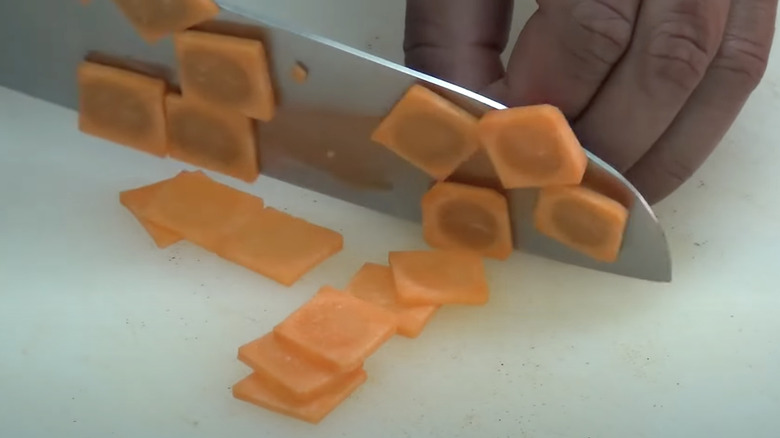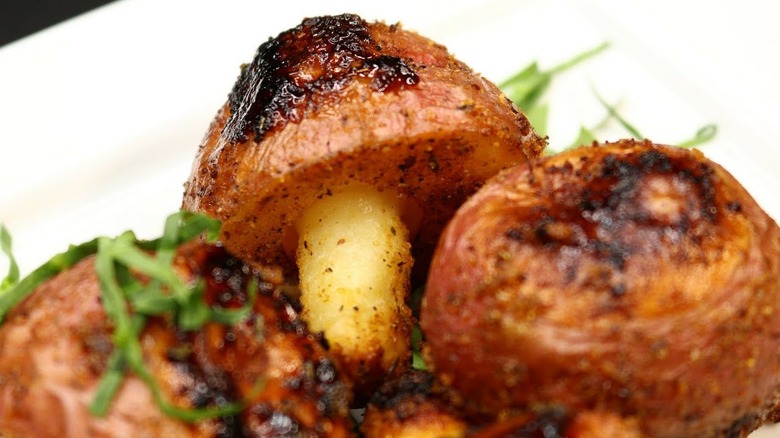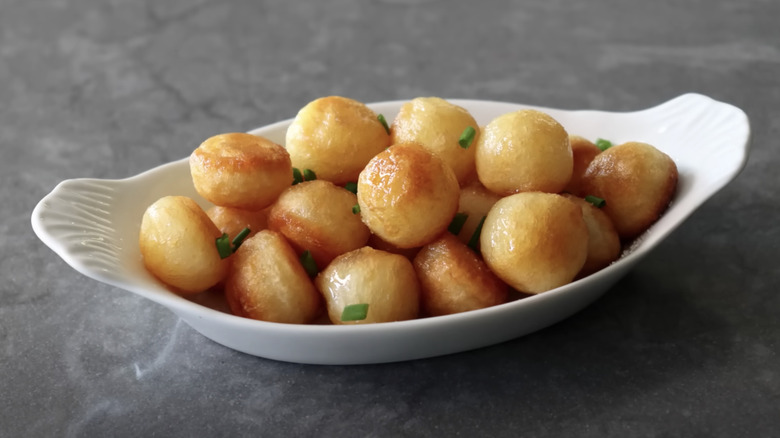18 Ways To Cut Potatoes And The Best Uses For Each
What would life be like without potatoes? They're healthy, come in many varieties, and can be cooked in an endless number of ways. From fried to fanciful, potatoes are one of the most popular crops in the world. In addition to the previously mentioned qualities, they require less attention than other crops yet still provide an enormous harvest. If that doesn't "fry" your brain, according to Statista, over 376 million metric tons of potatoes were produced globally in 2021 — that's nearly eight Titanic's-worth. There's no wonder why potatoes are a global staple.
When it comes to preparing these tasty tubers, the delicious possibilities are only bound by the limits of your imagination. That's the upside to having such culinary freedom, while the less vertical side is that you can't truly experience the potato's potential without first learning some basics. In particular, the different ways to cut potatoes and the best occasion for enjoying them. Whether you prefer cubed or crinkled, waffle or wedge, somewhere on this list is the perfect potato cut for you.
Skin-on fry cut
A low-prep option that's great as an afternoon snack, skin-on fries are a rustic alternative to the popular fast food-style skinless variety. In addition to a shorter prep time and an outback aesthetic, according to Potato Goodness, potato skin is packed with half of its total dietary fiber. Fiber is essential to a healthy digestive system. You'll commonly find this style of fry being sold at barbecue spots, Cajun restaurants, and alongside chicken wings. Fortunately, you can easily recreate that rustic charm at home, too.
When making skin-on fries at home, it's very important to clean your potatoes thoroughly with cool or lukewarm water. Soil residue on potatoes can sometimes house harmful bacteria and pesticides. You can clean, cut, and cook skin-on fries in a little over 30 minutes. One of the best parts about leaving the skin on is the added touch of crunch.
Cube cut (home-style) fries
Cube cut fries, popularly known as home-style, are the perfect complement to a plate of scrambled eggs and fruit. This diner staple is perhaps the humblest of potato-cutting methods and can range between chunks or slices, to small cubes or wedges. A far cry from the precisely measured techniques found in French cuisine, it's a no-frills approach to cutting. When it's all cut and done, they're fried in vegetable oil or butter and sometimes include chopped onions and green peppers.
The best part is that making a home fries recipe is simple. Unless you like to spice things up with your own blend of seasoning, all you really need is three ingredients. If you prefer your potatoes without all the bells and whistles, just pull out the vegetable oil and salt. After your 'taters have been cleaned and dried, toss them in the skillet, cover them with a lid, and cook for 5-10 minutes. Stir them until finished, plate, and enjoy.
Potato chip cut
A healthier alternative to store-bought chips, homemade potato chips is the elevated snack experience you've been missing out on. Compared to most popular brands they're healthier and can be customized with the seasoning blend of your choice. The only downside to making potato chips at home is the time it takes; the process itself is fairly straightforward. If the very mention of "prep" causes you to bare fangs, you may want to stick to your favorite brand, as this requires carefully slicing loads of potatoes.
According to the Food Network, one pound of potatoes only yields a paltry 4-ounce portion of chips. A mandoline is the most ideal tool for the job, but if you don't own one, a sharp knife will work just fine. Just be prepared to work up a serious sweat from cutting. Although making homemade potato chips is a commitment, it's one you're sure to fall in love with.
Waffle cut
These fun-shaped fries are less common than your typical fast-food-style fries, yet they offer the same deliciousness. Waffle fries, also known as lattice fries, or as the French say, gaufrettes, are the unexpected menu item that you're always pleasantly surprised to find. Crispy and crunchy, the criss-cross construction of a waffle fry makes it the perfect sauce stabilizer. If your "dip-game" needs some work, fret not, waffle fries are ideal for dippers of all skill levels.
The only hurdle to hop when making waffle fries is that it requires a special cutting device called a "waffle blade" (or wave-waffle). The unique blade can be fitted to a mandoline. With it, you can easily make a Chick-fil-A waffle fry copycat and save yourself a trip to the drive-thru. Aside from the special prep, waffle fries are one of the best potato cuts period.
Shoestring cut
When you prefer more crunch to potato filling, shoestring fries are a fun alternative to thicker-cut ones. Also called matchstick fries, these thinly cut treats are a mainstay on diner menus across America. Some like everything the Texan way, big, while others enjoy savoring smaller bites. We won't judge you either way, there's no fry discrimination allowed here at Tasting Table. Although easy to make at home, shoestring fries require a bit more prep time than their standard-sized cousins.
The first thing to be mindful of is how thinly you cut the potatoes. The general consensus amongst many home cooks and chefs is that the sweet spot exists somewhere between ⅛ inch to ¼ inch. Its size really depends on your crunch preference though. To cut down on prep time without sacrificing uniformity, we suggest using a mandoline. It'll give you the crave-worthy cut you're looking for.
Wedge cut
Potato wedges are one of the best appetizers around. They pair perfectly with everything from fried chicken and burgers to pizza and salads. Thicker than regular French fries, wedges are just as crispy and satisfying. When cooked right the crunchy skin gives way to a pillowy consistency that melts in the mouth. When cooked wrong, the soggy and chewy skin is enough to drive a wedge between you and a restaurant.
Unlike traditional fries, potato wedges are usually seasoned and savory without condiments. Their larger size allows for more liberal use of spices and herbs, without overwhelming the potato taste. The cutting technique is important to achieving uniform wedges that will bake evenly. You start by cutting your potatoes in half lengthwise then placing them cut-side down. Using each half, you should be able to cut between six to eight wedges. You can also cut time in half by using an apple slicer.
Crinkle cut
Another dip-friendly way to cut potatoes is into crinkle fries. Crinkle-cut fries combine the zig-zag-like style of waffle fries with the classic standard cut of French fries. They're larger than traditional fries too, which means they have more surface space to lather with tasty condiments and can retain crunchiness longer. That's why crinkle-cut fries have a gastronomic purpose and are a popular fry choice for many fast food spots.
In other words, you don't have to worry about ketchup splattering your shirt like a Pollock painting. Its ridged design helps to secure sauce as the fry travels from the dip to your mouth. Crispy and golden colored on the outside, and moist on the inside, crinkle-cut fries deserve its spot near the top of the "best types of fries list." If you're looking for satisfaction and scoopability, make yourself some crinkle-cut fries.
Julienne cut (standard cut)
One of the appeals of home-style cooking is its novel aesthetic. For example, there's something "elevated" about skin-on fries that fast food fries don't carry. The rustic charm is in stark contrast to the uniformity of classic McDonald's fries. While the debate over which is tastiest is never-ending, in truth, when cooked right, they're both pretty darn delicious. Skin-on 'tates are perfect for any occasion, but if you want to recreate the fast food French fry experience at home, you'll need to use a French cutting method.
Like many French cutting techniques, the Julienne cut is actually simpler than its fancy name may suggest. The goal is to cut ingredients into identical long, thin strips. The precise measurement used in French cuisine is around 16th to an ⅛-inch thin and 2-to-3 inches long. Aside from potatoes, the Julienne cut can be used on vegetables, cheeses, and meats, too.
Potato skin cut
Potato skins are the cure for game-day cravings. They're the pub grub go-to that prevents next-day hangovers. More specifically, potato skins are unpeeled potato halves that have been scooped free of flesh, leaving a hallowed potato skin that you can top with ingredients. These bites are traditionally topped with shredded cheddar cheese, bacon crumbles, sour cream, and chopped scallions. But you're always encouraged to set tradition aside and customize it to your palate's liking.
In order to achieve perfectly shaped potato skins, you need to use a serrated knife. This will let make clean cuts without tearing the skin in the process. Before you scoop the potatoes, you should slice an outline around the area of the potato where you plan to remove the flesh. Try to keep the outline about a ¼ inch from the skin. Rinse and repeat with your other potatoes.
Hasselback cut
If you're looking for crispy, filling, and cool-looking, Hasselback potatoes should be next up on your recipe list. According to Lunds and Byerly's, Hasselback potatoes get their name from a Stockholm-based restaurant named Hasselbacken and were introduced as a menu item in the 1940s. Unlike some of the other unique methods of cutting potatoes, Hasselback doesn't require any fancy tools, only a simple chef's knife.
These oven-ready treats are the perfect way to put a twist on traditional baked potatoes. Although regular-style baked spuds have everything you need to satiate hunger pangs, Hasselback has that along with an eye-catching flare worthy of talking about. To get the perfect Hasselback potatoes, you'll need to employ a meticulous cutting technique along with another surprising tool: Chopsticks. Using chopsticks will help prevent over-slicing the potato, which can ruin the lovely end result. After you've perfected the uniform cuts, level things up with this Greek sausage and Hasselback feta potatoes recipe.
Accordion cut
What's the famous saying: "Don't play with your food?" Well, you'll have to make an exception for this super fun potato-cutting technique. Accordion-cut potatoes are one of those innovative ideas that makes it hard to decide whether to eat them or stare in awe. Requiring meticulous slicing, accordion-cut potatoes carry an aesthetic that works well in humble and fanciful settings alike. They're like a fusion of Hasselback and tornado-style potatoes.
Despite their elaborate appearance, pulling off superbly sliced accordion potatoes is completely doable. You'll mainly need a sharp knife, skewers, and of course, a few spuds. You begin by washing the potatoes, halving them lengthwise, then slicing them into wedges. Set the wedges cut-side down, position them horizontally, and then place skewers on either side. The skewers have dual purposes: first to prevent you from slicing all the way through, and then later as a serving stick.
Next, slice vertical lines on one side, then flip it over and do the same, except slice diagonal lines instead. After you finish slicing each side of your wedges, carefully pierce them through the center with a skewer. Now here comes the fun part, gently stretch the potato apart on the skewer until it resembles an accordion. The final touch before putting them in the oven is to brush them with a little bit of garlic butter.
Tornado cut
Just when you think we've reached the pinnacle of potato-cutting techniques, someone comes along and invents tornado-cut potatoes. You've probably seen this funky style popping up at summer food markets and local music festivals. Beyond being perfectly Instagrammable, eating tornado potatoes makes you feel like a kid again. They're a great example of just how adaptable potato flesh is, which leaves the door open for endless possibilities.
This cool and complex-looking cut takes what accordion potatoes do well and ups the wow factor. As the name suggests, tornado-cut potatoes resemble a spiral shape, which is reminiscent of a whirlwind. Guessing "potatornado" was out-voted. They actually originate in South Korea, where it enjoys more fanfare than in the States. It was made possible by repurposing a machine originally meant for peeling persimmons — it took two years to work the kinks out.
Tournée cut
Whip this fancy cut-out on special occasions. The tournée-cut method comes from French cuisine and means "turned." Sleekly eye-catching, it's a rotating technique usually employed for formal occasions and involves cutting hearty vegetables into uniform elliptical shapes, which helps them cook evenly. If it sounds meticulous, you're absolutely correct. At the same time though, with a bit of practice, it's easier than you might expect.
Properly cut tournée potatoes are seven-sided and symmetrically sound enough to be stacked together. In order to pull it off you need a bird's beak paring knife or a regular paring knife. First, remove the top and bottom of the potato so that you can place it cut-side down. Next, using your paring knife, slice from top to bottom while rotating, until it resembles a football. The odds of you getting it right on the first try are slim, but if you keep at it, you'll find it's a skill that is totally worth knowing.
Sliced potatoes
Probably the simplest and first cutting technique you'll use on potatoes is the slice. No measurements are needed and uniquely-shaped knives aren't necessary. The only thing you have to decide is whether or not you wanna keep the skin on. Sliced potatoes are used for everything from homestyle fries to potatoes au gratin. Skin-on is great for the former option while removing the skin is recommended for the latter.
In fact, potatoes au gratin are great for feeding a table full of hungry dinner guests and impatient kids alike. Whereas russets are preferred for homestyle fries, Yukon gold spuds work best for potatoes au gratin because they're less starchy, sweeter, and more creamy. There's just no way you can go wrong with a creamy blend of potatoes, cheese, and herbs. Next time you're at the grocery store, grab some Yukon golds and try this potatoes au gratin with gruyere recipe.
Fondant cut
Calling all gourmands! This next fancy cut is definitely worth whipping out the Swarovski toasting flutes for. The fondant cut refers to a classic French dish named pommes de terre fondantes (or fondant potatoes). Carefully carved to resemble "potato scallops," these small cylindrical treats are great examples of why you don't need pricey ingredients to cook something elegant. Fondant means "melting" in French and also describes the uber-involved process of cooking this fancy potato dish. It's a delicacy known for having a creamy and tender consistency, and to achieve that it requires both frying and roasting the potatoes.
In the first part of the cooking process, the fondant-cut potatoes are fried in butter or oil, garlic, and thyme — in an ovenproof skillet. For the second step, place the skillet into the oven with stock and roast the potatoes until they're crisp on the outside. The leftover stock can also be used as a creamy sauce.
Paysanne cut
Man ... those French sure have a lotta cutting techniques! Precision aside, the world is all the better for France's contributions to the culinary arts. Along with the Julienne, tournée, and fondant cuts, another useful cutting technique for potatoes is called the paysanne. In French cuisine, it's a method typically used when you want to reduce the cooking time of sautéed vegetables. The uniformity of the cut is what helps veggies cook faster and more evenly.
While it isn't considered as "precise" as some of the other French cutting techniques, the paysanne cut is a far cry from basic chopping — there is an actual specific measurement. Paysanne slices should be 1-milimeter thick, or just over 1/32inch. When you're finished, it should resemble a small square. Try the paysanne cut next time you need to prep veggies for soup, a creamy pasta sauce, or even stir-fries.
Mushroom cut
This next potato-cutting technique isn't for the faint of heart, you'll need to put all your skills to work. The mushroom cut is literally what you imagine; potatoes cut into the shape of a mushroom. While the accordion cut is impressive for its complexity, the mushroom cut evokes the same for its simplicity. It transforms the humble potato into a fun piece of edible art. If you're looking for a conversation starter, trust us, dinner guests will find it impossible not to talk about these tiny 'tates.
To do the mushroom cut, you need an apple corer and a dash of patience. You begin by sticking the apple corer into an unpeeled potato a ½-inch deep. Leaving the corer inside, slice away the parts of the potato around the corer until the "stem" remains. When you're finished, remove the corer, and your potato should resemble a mushroom.
Parisian scooped
A surefire way to impress someone with your cooking is by using this next potato-cutting technique. Different from most cutting techniques, this one actually doesn't involve cutting at all, but rather, scooping. Add Parisian scooped potatoes to the long list of culinary blessings France has bestowed upon the world. They're tiny ball-shaped fried spuds that you've probably already started drooling over while reading this, and they aren't easy to pull off either.
To make Parisian scooped potatoes you need a special tool called a Parisian scooper (or melon baller). It somewhat resembles a measuring spoon and is commonly double-sided with scoopers of different sizes. The spoons have holes in them that create a suction effect when scooping which helps secure the goods. When using it on a potato, we suggest leaving space between scoops and only scooping between eight to nine balls per 'tate. After you complete the arduous prep process, cooking these savory spherical snacks takes less than 10 minutes.
